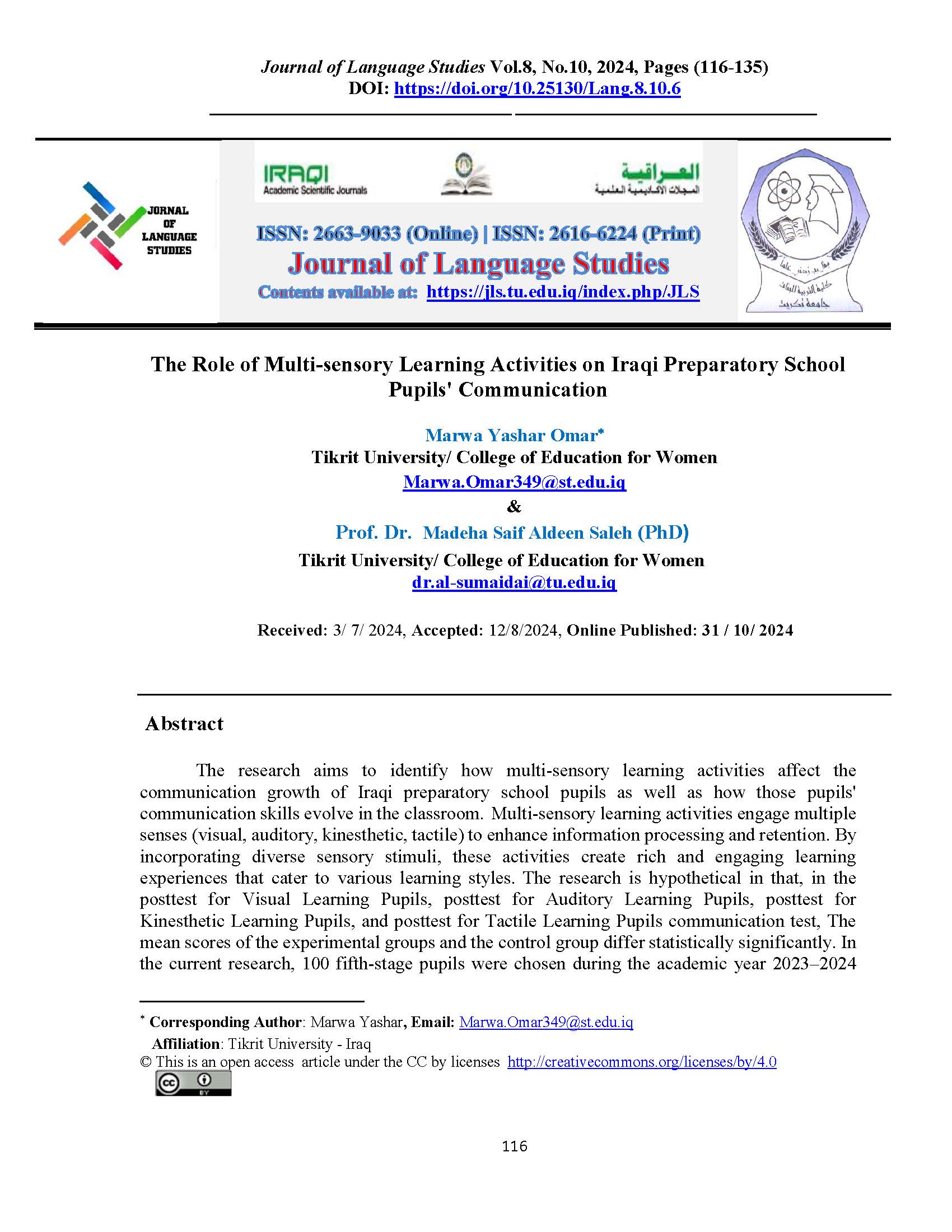The Role of Multi-sensory Learning Activities on Iraqi Preparatory School Pupils' Communication
DOI:
https://doi.org/10.25130/Lang.8.10.6Keywords:
Communication, Concept of multi-sensory learning activities, Role of Multi-sensory Learning Activities on Pupils' CommunicationAbstract
The research aims to identify how multi-sensory learning activities affect the communication growth of Iraqi preparatory school pupils as well as how those pupils' communication skills evolve in the classroom. Multi-sensory learning activities engage multiple senses (visual, auditory, kinesthetic, tactile) to enhance information processing and retention. By incorporating diverse sensory stimuli, these activities create rich and engaging learning experiences that cater to various learning styles. The research is hypothetical in that, in the posttest for Visual Learning Pupils, posttest for Auditory Learning Pupils, posttest for Kinesthetic Learning Pupils, and posttest for Tactile Learning Pupils communication test, The mean scores of the experimental groups and the control group differ statistically significantly. In the current research, 100 fifth-stage pupils were chosen during the academic year 2023–2024 from Aghalar Preparatory School for Boys. Every group is equal in terms of age and parents' level of education.
The researcher statistically analyzed the data collected from the four post-test outcomes using one-way, two-way, three-way, and four-way ANOVA (analysis of variance) to gauge the pupils' post-test communication. Multi-sensory learning activities are more successful than using the traditional approach for communication, The results demonstrate a statistically significant difference in mean scores between the experimental groups and the control group. Concluding remarks, suggestions for more research, and recommendations complete the research.
References
Ahmed AL-ahbaby, T. D., & Al Azzawi, I. T. (2024). The influence of strategic competence on Iraqi EFL university students’ conversations. JOURNAL OF LANGUAGE STUDIES.
Arain, M., Campbell, M. J., Cooper, C. L., & Lancaster, G. A. (2010). What is a pilot or feasibility study? A review of current practice and editorial policy. BMC Medical Research Methodology, 10, 67.
Arikunto, S. (2006). Dasar-Dasar Evaluasi Pendidikan. Jakarta: Bumi Aksara.
Bain, K. (2007). What the best college teachers do. Harvard University Press.
Best, John W. and Kahan, J. (2006) Research in Education. (10th ed.) United States of America: Pearson Education, INC.
Boaler, J., Munson, J., & Williams, C. (2022). Mindset Mathematics: Visualizing and investigating big ideas. San Francisco: Jossey-Bass.
Brown, H.D. (2nd ed.) (2001). Teaching by Principles: An Interactive Approach to Language Pedagogy. San Francisco, California.
Brown, H.D. and Abeywickrama, P. (2010). Language Assessment: Principles and Classroom Practices. Pearson Education. White Plains, NY.
Cakir, I. (2006). The use of video as audio-visual material in foreign language teaching classrooms. The Turkish Online Journal of Educational Technology.
Cortiella, C. (2011). The state of learning disabilities. New York, NY: National Center for Learning Disabilities.
Denig, Stephen J (2004). "Multiple Intelligences and Learning Styles: Two Complementary Dimensions". Teachers College Record, Columbia University.
Garner, R. (1999). Multisensory instruction: Research and applications. Educational Leadership.
Gillingham, A., & Stillman, B. W. (1997). The Gillingham Manual: Remedial training for children with specific disability in reading, spelling, and penmanship (8th ed.). Westford, MA: School Specialty.
Hoisington, B. (2015). Multisensory Activities to Teach Reading Skills.
Hughes, A. (1989). Testing for language teachers. Cambridge University Press.
Hughes, A.( 2005). Testing for Language Teachers. 2nd Ed. London: Cambridge University Press.
Ibrahim, S.O.(2023).The Influence of Non-verbal Communication among University Students on Social Relationships.JOURNAL OF LANGUAGE STUDIESl.
Kayalar, F., & Kayalar, F. (2017). The effects of Auditory Learning Strategy on Learning Skills of Language Learners (Students’ Views). IOSR Journal of Humanities And Social Science.
Kirk, R.E. (2013). ''Research Strategies and the Control of Nuisance Variables.
Lane, C. (n.d.).Gardner's multiple intelligences. The distance learning technology resource guide.
Lehman, Irvin and Mehrens, A. (1971). Educational Research Reading in Focus. The USA.: American Winston, Inc.
Maree, J. G. & Fraser, W. J. 2004. Outcomes-Based Assessment. Sandown: Heinemann.
Moats, L. C., & Farrell, M. L. (2005). Multisensory structured language education. In J. R. Birsh (Ed.), Multisensory teaching of basic language skills. Baltimore: Paul H. Brookes Publishing Co.
Mortimore, T. (2008). Dyslexia and learning style: A practitioner's Handbook. Hoboken, NJ: John Wiley & Sons.
Richards, Jack C., and Richard W. Schmidt (2013). Longman Dictionary of Language Teaching and Applied Linguistics. Routledge.
Rivers, W. M. (1981). Teaching foreign language skills. Chicago: Univ. of Chicago Press.
Rusinko, J. E. (2011). A proposed theoretical model of literacy learning using multisensory structured language instruction (MSLI), Antioch University Seattle.
Sitihendon and Khalijah, (2007). "Science teaching for entertainment: a holistic approach in developing a teaching guide for best practices at secondary level". Asian Pacific Forum on Science Learning and Teaching,
Smith, J. (2018). Teaching to all learning styles: An evidence-based approach (3rd ed.). SAGE Publications.
Stein.BE (2012) The New Handbook of Multisensory Processing. Cambridge (MA): MIT Press.
Tomlinson, C. A., & Bryant, D. R. (2003). Differentiation in action: Strategies and techniques for meeting the needs of all learners.
Weber, P. M. (2000). Teaching Students with Auditory Learning Styles.
Wood, D. A. (1960). Test construction: Development and interpretation of achievement tests. Columbus, OH: Charles E. Merrill Books.

